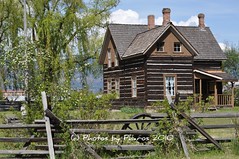All the new construction in Kelowna today might give visitors the impression that this city in BC's Okanagan is relatively new. They'd be woefully wrong.
| Pandosy Mission, 2010 |
.jpg) |
| In their later years |
The mission's original bell led me to another Kelowna story of courage and success. The bell acted as Rosa Casorso's traveling companion and compass in 1884 when she left Italy with three small kids to join her husband who was working for – you guessed it – Pandosy. She spoke not one word of English when her ship docked in San Francisco having sailed round Cape Horn; all she had was a scrap of paper with the address "Father Pandosy, Okanagan Mission." So did the bell .... Rosa followed the bell on horseback, in canoes and wagons, and on foot, and eventually was reunited with her husband Giovanni, whom Pandosy renamed John.
The couple went on to establish the biggest agricultural and horticultural empire in BC's interior and the family still operates it today.
 |
| Pioneer Market in 2013 |
.jpg) |
| Jams, jellies, and honeys |
Tucked behind the market is the tasting room of Sperling Wines, formerly Calona Wines, another of the Casorso's enterprises dating from 1925 when Giovanni's son, Charles, planted the first vineyard in the Kelowna region. It still exists and produces several varieties of wine. We tried a few, but I didn't care much for the pinot gris or chard. My husband liked the old vines Maréchal Foch and bought two bottles.
Life was tough homesteading in the late 1800s, and Rosa made it work; she not only founded a family firm but also raised nine children and cooked meals for them and twelve farmhands. I could scarcely imagine her daily life standing looking at the farm and vineyards, to say nothing of her journey from the Old World.
ALL IMAGES: © Photos by Pharos 2010-13. All rights reserved.


Nice article Julie - I lived there and drove past the mission regularly and didn't stop. Shame on me for not seeing something right under my nose. I will definitely visit it the next time I am in Kelowna.
ReplyDeleteGreat post Julie! Thanks for highlighting this fascinating bit of Kelowna history. I love that Rosa Casorso story - how wonderful to showcase a resourceful and tough lady.
ReplyDeleteThank you, Carol and Catherine. I'm so glad you enjoyed this post. I had a great time writing it!
ReplyDelete